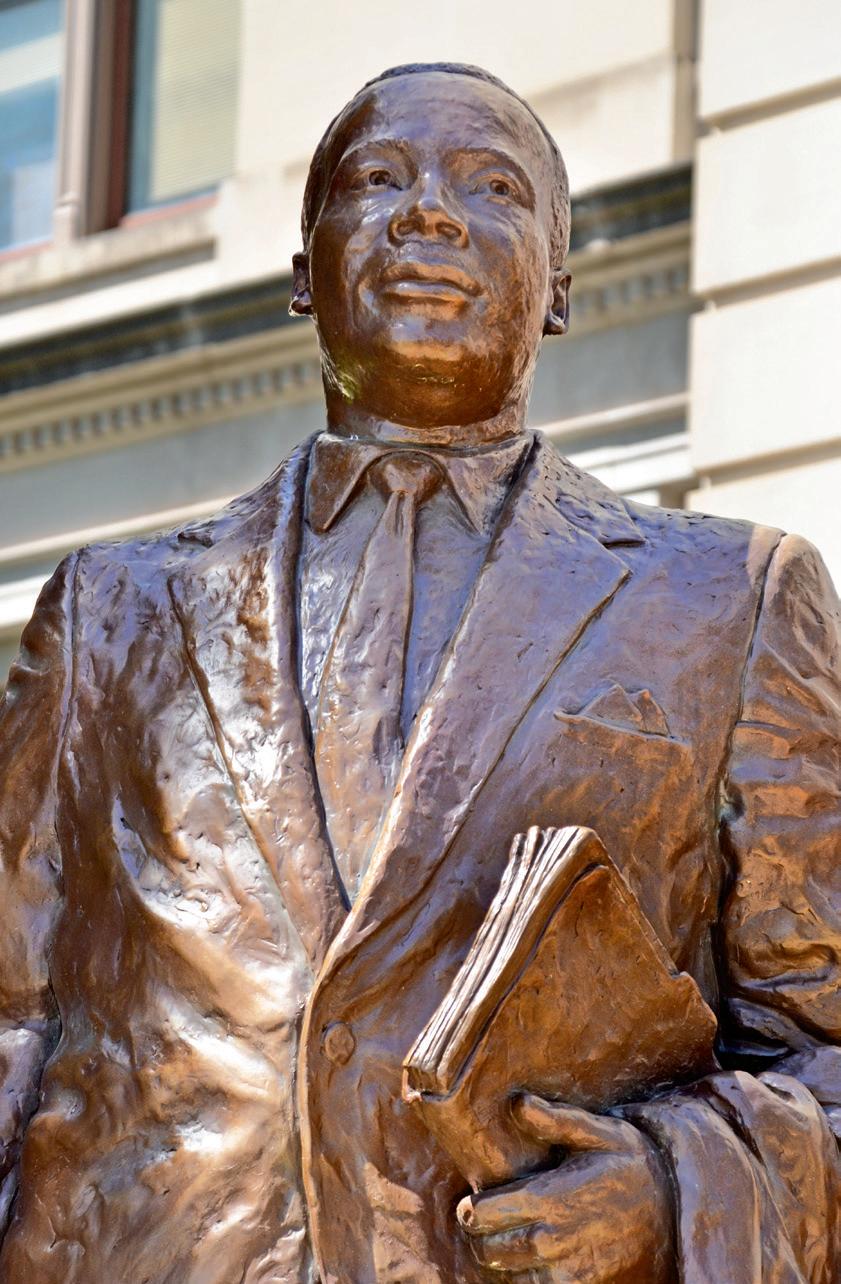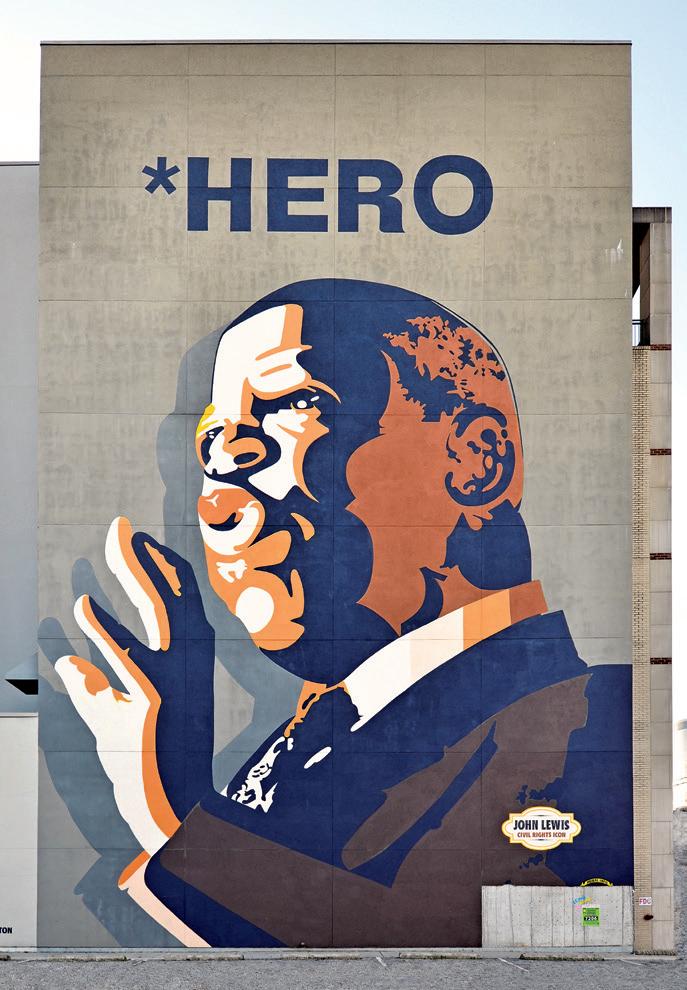
4 minute read
INSPIRED BY THEIR FOOTSTEPS
Gather inspiration from three Atlanta civil rights heroes who have passed away in 2020. Then, in their memory, visit our list of civil rights sculptures, murals and art installations around the city. BY LIESL MERKEL
Atlanta was a cultural center for the American civil rights movement, thanks in part to the Sweet Auburn district where activists gathered to generate ideas and to, as civil rights leader and Congressman John Lewis said, “get in good trouble.”
In 2020, Atlanta lost three heroes of the movement. Rev. Joseph Lowery passed away in March, then Rev. C.T. Vivian and Congressman John Lewis both passed on July 17, 2020.
WHO WERE THESE HEROES?
Rev. Joseph Lowery helped found the Southern Christian Leadership Conference (SCLC) with Martin Luther King Jr. and others, serving as its president (1977- 1997). Rev. Lowery also created the Black Leadership Forum and was called the “Dean of the Civil Rights Movement” for his presence in many of the major movement activities including the Selma to Montgomery march of 1965 and the Montgomery Bus Boycott.
Rev. C.T. Vivian helped found the Nashville Christian Leadership Conference, organized the first sit-ins in Nashville, and participated in the Freedom Rides. He 16 DISCOVERATLANTA.COM worked beside Martin Luther King Jr. as the national director of affiliates for the SCLC and also conceived and directed civil rights organizations including Vision, which awarded scholarships to 702 Alabama students, and the National Anti-Klan Network, which later became the Center for Democratic Renewal.
Congressman John Lewis served as the chairman of the Student Nonviolent Coordinating Committee (1963-1966) and helped organize the 1963 March on Washington. He led the first march from Selma, Ala., to Montgomery in what became known as Bloody Sunday where Lewis and the marchers were attacked by police. The incident ultimately led to the 1965 Voting Rights Act. His leadership continued as he served in the U.S. House of Representatives from 1987 until his death, representing the 5th congressional district of Georgia which includes most of Atlanta.
As we remember these revolutionaries, we also look to where we can celebrate their legacy and carry on their mission of equality, freedom and hope. Take a quiet moment to visit these installations. View, learn, and plan for the future.
John Wesley Dobbs “Through His Eyes” Far left: Martin Luther King Jr. Statue stands outside the Georgia State Capitol

“HERO”

IN THEIR MEMORY AND HONOR “HERO” Corner of Auburn Avenue and Jesse Hill Jr. Drive Artist: Sean Schwab
This tribute to Congressman John Lewis features a quote from Lewis’ speech at The March on Washington.
Martin Luther King Jr. Statue Georgia State Capitol Artist: Martin Dawe
Dr. Martin Luther King Jr. is an icon of the American civil rights movement and an alumnus of both Atlanta’s Booker T. Washington High School and Morehouse College.
Andrew Young Statue Corner of Andrew Young International Boulevard and Spring Street Artist: John Paul Harris
A civil rights activist and protégé of Dr. King, Andrew Young became mayor of Atlanta and U.S. ambassador to the United Nations under President Jimmy Carter.
“Atlanta and the Civil Rights Movement, 1944-1968” Atlanta BeltLine Curated by: Karcheik Sims-Alvarado, Ph.D.
These photographs are presented across four miles of the Eastside and Westside Trails of the BeltLine. It is the longest outdoor exhibition on civil and human rights in the United States.
Charles Lincoln Harper Statue Ashby Garden Park at Ashby Circle NW and Mayson Turner Road Artist: Ed Dwight
Charles Lincoln Harper was the first principal of Atlanta’s Booker T. Washington High School, the city’s first post-6th grade public school for African Americans.
“Expelled Because of Their Color” Georgia State Capitol Artist: John Thomas Riddle Jr.
This monument pays tribute to African American legislators in Georgia who were expelled from the Georgia General Assembly during Reconstruction because they were Black.
“Lifting The Veil of Ignorance” Booker T. Washington High School Artis: Charles Keck
This statue portrays Washington lifting the veil of ignorance from his people, symbolized by a terrified slave. The slave holds a book representing education and crouches on a plow and anvil, representing tools of agriculture and industry.
Benjamin Mays Statue Morehouse College Artist: Ed Dwight
A mentor to Dr. Martin Luther King Jr., Benjamin Mays was president of Morehouse College from 1940 to 1967. As the first African American president of the Atlanta Board of Education, he presided over desegregation of Atlanta Public Schools.
“Homage to King” Intersection of Ponce de Leon Avenue and Freedom Parkway Artist: Xavier Campaney Medina
This steel sculpture welcomes visitors to the Martin Luther King, Jr. National Historical Park.

"Lifting The Veil of Ignorance"
“Behold” Martin Luther King, Jr. National Historical Park Artist: Patrick Morelli
The statue depicts an African-American man performing an ancient African ritual of holding his newborn up toward the heavens.
John Wesley Dobbs “Through His Eyes” Auburn Avenue at Fort Street Artist: Ralph Helmick
John Wesley Dobbs was a civic and political force in Atlanta and was known as the unofficial mayor of the city’s famed Auburn Avenue.
BY LIESL MERKEL





